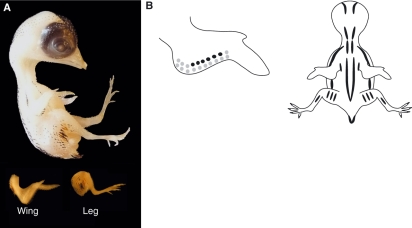Fig. 6.
(A) Stage 37 (9.5 days) quail embryo, including limb detail. (B) Schematic representation of the average pigmentation pattern seen at stage 37 on the wing and the dorsal surface of the embryo. Pigmentation is visible on the head, with black pigmentation present on the forehead and crown. Pigmentation continues to increase either side of the spine over the regions of the scapula and ulna, on the thigh and at the edge of the tail. A single distinct line of black feathers in the region of the coracoids is now prominent, with a second and sometimes third line beginning to appear either side of the first row. Golden-brown pigmentation also increases most notably in the regions of the scapula, ulna, thigh and the edge of the tail. Additional golden-brown pigmentation is apparent in the lumbosacral region when viewed microscopically. The average beak length is 1.5 mm and the third toe length is 4.1 mm.

